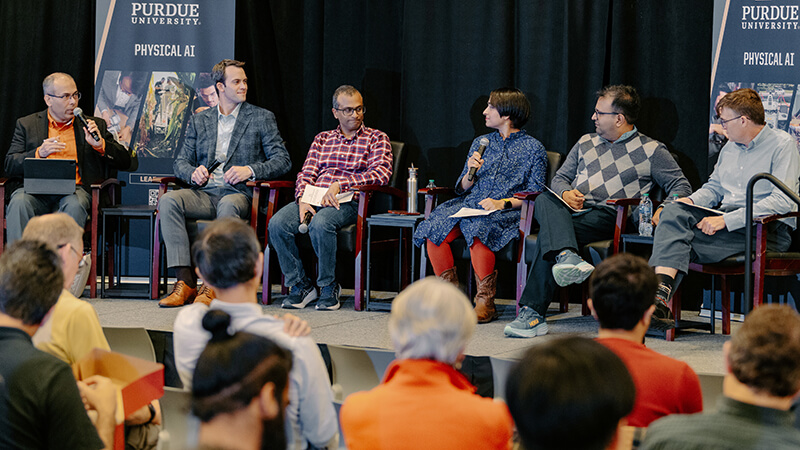Emerging field of physical AI takes shape in wide-ranging discussion

Industry leaders convened at Purdue University last month for a robust discussion on integrating AI in the physical world. The event, which was sponsored by the university’s Institute for Physical AI (IPAI) included representatives from Amazon, Argonne National Laboratory, Caterpillar, Southwest Airlines and Purdue.
“We at Purdue truly believe not only in foundational AI, which is critical to what we’re doing now, but also in translating that to real-world applications,” said Karen Plaut, Purdue’s executive vice president for research. “Manufacturing, agriculture, aviation, health, biology — there are so many industries that we can positively impact through the use of AI.”
In their discussion, panelists explored the unique challenges of integrating AI into the physical world as opposed to developing purely virtual AI. Among those challenges are the significant infrastructure changes that will likely be required to support autonomous vehicles and other machinery. Panelists concluded AI’s payoff has the potential to free humans from mundane tasks in favor of more creative work.
The panelists were: Somali Chaterji, assistant professor of agricultural and biological engineering at Purdue; Jim Katter, director of engineering, artificial intelligence at Caterpillar; Anthony Gregory, chief operating officer at Southwest Airlines Renewable Ventures; Arvind Ramanathan, computational biologist at Argonne National Laboratory and senior scientist at the University of Chicago Consortium for Advanced Science and Engineering; and Shiv Vitaladevuni, director of applied science, Amazon.
Moderator Saurabh Bagchi, Purdue professor of electrical and computer engineering and member of the IPAI Steering Committee, said the panelists clearly spoke of physical AI as “a distinct area of exploration and technical development.”
As the panelists discussed, the rewards of success in physical AI are significant. In research, physical AI is being used to help determine which experiments would be most productive and even autonomously order samples, measures that help researcher keep pace with the capacity of complex instruments and improve the overall process of discovery. AI tools like co-pilots improve software development productivity and also provide assistance that allows engineers and designers to focus on the more creative aspects of their work.
However, reaping those rewards will take a shift in how we approach physical AI.
Most large language model systems currently in production have been trained on text, stripping it from a physical context, the panelists explained. If AI can be trained in a physical context, we could expect systems to extract far greater insights relative to virtual-only systems. Well-considered guidelines of safety, reliability, predictability, privacy and explainability will be needed to accompany such systems, which will be capable of perceiving, understanding and manipulating the physical environment.
Panelists also highlighted the need for significant infrastructure changes to support physical AI. Given that most autonomous vehicles will be electric and will generate massive amounts of data during normal operation, the performance of autonomous systems could outpace the physical capacity of the world to support those systems. To meet energy and data transfer constraints, more efficient algorithms will be needed to govern embedded devices, like sensors and actuators. An entire research field could emerge to explore how AI models interact with the physical world and how we humans can interact with such models.
IPAI is part of the Purdue Computes initiative, which includes investments in Purdue’s computing faculty and in research on physical AI, semiconductors, and quantum technologies.